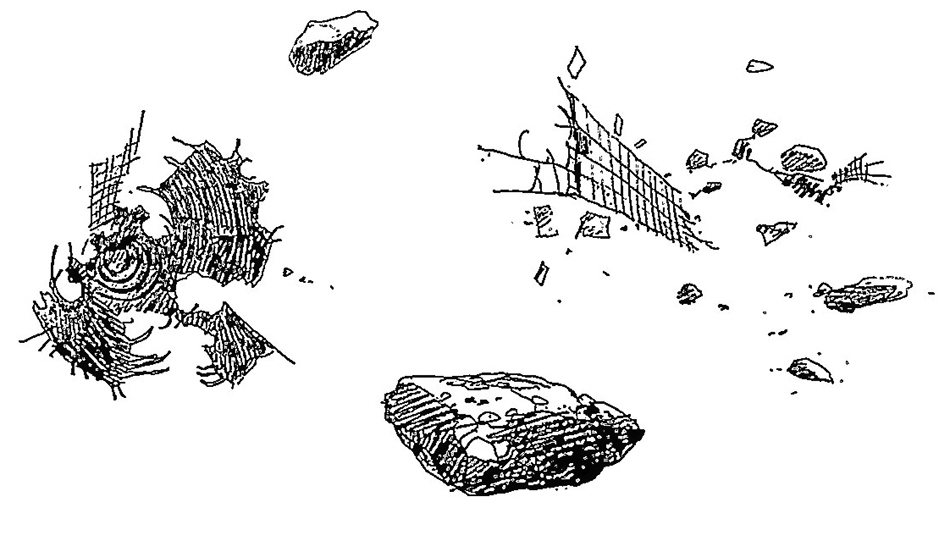SHOAL ZONE
暗礁宙域
SHOAL ZONE
![]()
The remnants of colonies, satellites, asteroids brought in for resource extraction for colony construction, and fragments of warships destroyed in combat are generally referred to as space dust. If the environmental pollution caused by colony drops is the most significant scar left by the One Year War on Earth, then the most significant scar it left in space is the vast amount of space dust (also known as space debris).
This debris, influenced by gravity, gradually clumps together, drifting in space along specific orbits or being drawn towards Earth or the moon, potentially falling to their surfaces. On Earth, smaller fragments burn up due to atmospheric friction (when combat occurs in satellite orbit, fragments raining down towards the planet create a spectacle similar to shooting stars), but larger ones can reach the surface. On the moon, without an atmosphere to act as a shield, these fragments plummet unimpeded, posing a risk to cities and navigating spacecraft.
An area dense with such debris is collectively known as a shoal zone (sometimes referred to as a shoal sector). These zones are obstacles to spacecraft navigation, hence the term “shoal.” The main concern is not running aground, as with sea vessels, but rather the risk of collision. However, since these zones are gravitationally aggregated and drift through space along specific orbits, their absolute coordinates are not fixed, allowing for possible navigation through them.
Passing through a shoal zone carries the risk of colliding with floating objects, as well as debris from destroyed equipment and man-made structures. Larger objects can be visually detected, but smaller fragments, hurtling at tremendous relative speeds, are challenging to avoid. The aftermath of battles in space also sees similar hazards, with flying metal shards capable of damaging the armor of spacecraft and mobile suits. It’s said that half of all equipment malfunctions on the battlefield were caused by such debris. Consequently, external operations in these areas were impossible without protective shields (early in the One Year War, the impact of these fragments was not considered, leading to numerous accidents where metal shards struck workers. The human toll led to the implementation of protective shields during operations, but these shields were virtually ineffective against metal fragments moving at several kilometers per second. The most significant reduction in damage came from minimizing extravehicular activities in battle zones and shoal areas, which, however, delayed repair responses and reduced the operational rate of spacecraft. To date, no effective means have been developed to protect ships and workers from these metal fragments. Theoretically, creating a beam shield around ships has been proposed, but with current technology, it remains an unfeasible dream).
The most notorious shoal zone lies in the Halo orbit at L1, the area of Side 5 devastated during the Battle of Loum, where numerous damaged and discarded ships, fighters, mobile suits, and other machinery from the largest fleet battle in human history drift. Its extensive scale often leads to this particular area being synonymously referred to as a shoal zone. Especially around the Texas colony, a tourist colony, the dense obstacles have given the Texas Area its nickname, synonymous with shoal zones.
Strategically and tactically, shoal zones have been frequently utilized since the One Year War. The difficulty of electronic detection, such as radar, due to the large and small space dust scattered in the danger zone, was used to conceal fleets and units. Especially when Minovsky particles are dispersed in a shoal zone, detection becomes utterly impossible, necessitating completely visual navigation for the concealed fleet or troops, inherently fraught with danger. However, the risk of being detected by the enemy in secret operations outweighs other dangers, justifying the utmost caution.
Tactically, during the Battle for Solomon in the One Year War, the Federation’s 3rd Battalion (nicknamed the Wakkein fleet) assembled near Side 4 at L4, while the main Federation Forces 2nd Combined Fleet (nicknamed the Tianem fleet) concealed itself within the remnants of Side 1 at L5. Strategically, remnants of the Principality’s forces built the anchored base “Garden of Thorns” within the Side 5 shoal zone, later known as the Delaz Fleet’s stronghold. Although one might imagine the risk of damage from dust, the Delaz Fleet managed to remain concealed there for three years, benefiting from its deep placement within the zone, where larger floating debris acted as protective barriers, preventing smaller, harmful dust from reaching the anchored base.
Currently, for Earth and its orbital routes, low-orbit defense satellites are deployed to destroy or melt approaching space dust with beam cannons. However, the issue of dealing with space dust forming shoal zones remains unresolved.
![]()





